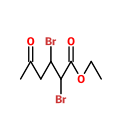According to Section P-41 in the current version of Nomenclature of Organic Chemistry – IUPAC Recommendations and Preferred Names 2013 (Blue Book), the order of seniority of classes in decreasing order of seniority is as follows.
(…)
9. esters
(…)
16. ketones
(…)
Therefore, the compound that is given in the question is named as an ester.
The names of esters are usually formed by placing the alcoholic component in front of the name of the acid component as a separate word.
P-65.6.1 General methodology
Neutral salts and esters are both named using the name of the anion derived from the name of the acid. Anion names are formed by changing an ‘-ic acid’ ending of an acid name to ‘-ate’ and an ‘-ous acid’ ending of an acid name to ‘-ite’. Then, salts are named using the names of cations, and esters the names of organyl groups, cited as separate words in front of the name of the anion.
Therefore, the name of the parent structure without further substituents is ethyl hexanoate.
This ester is substituted using the usual principles of substitutive nomenclature. A low locant is assigned first to the principal characteristic group (i.e. the ester group). The prefix ‘oxo’, denoting $\ce{=O}$, is used to indicate a carbonyl group when the group cannot be cited as suffix.
Thus, the complete name for the compound that is given in the question is ethyl 2,3-dibromo-5-oxohexanoate.



